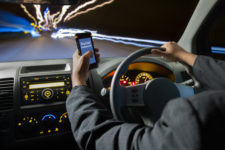Thousands of Drivers Allegedly Caught by Mobile Phone Detection Cameras

Just over a week ago, the New South Wales Government introduced new mobile phone detection cameras across the state. During that period, more than 3,000 drivers have allegedly been caught illegally using their phones while driving.
Around 45 fixed and mobile trailer-mounted cameras were switched on across the state at early this month to catch motorists engaging in conduct that can lead to accidents and even deaths.
Hundreds of thousands checked
The new cameras are reported to have checked more than 770,000 vehicles, and 3,303 drivers were detected allegedly using their phones in an illegal manner.
But thanks to a three month grace period, these drivers won’t receive a fine or demerit points. They will however, receive a warning letter.
The grace period will end at the start of March 2020. After this, drivers who are detected by the cameras will receive a $344 fine and five demerit points. The penalty is bumped up to $457 for those driving in a school zone or up to ten demerit points for those caught in a school zone during a double demerits period.
No warning signs
Unlike speed cameras, there are no warning signs to alert drivers to the presence of mobile detection cameras.
The technology
The high-definition cameras claim to capture clear images of the front seats of vehicles as they drive past. They are said to be so sophisticated that they are capable of catching drivers at night, in poor weather conditions and at speeds of up to 300km/h.
There are, however, concerns that the images are reviewed by Artificial Intelligence, and that the automated system will result in the issuance of fines to those who have done nothing wrong – in which case the onus will unfairly be on them to contest the fines.
These concerns are magnified by the failure of image detection software both in Australia and overseas, which has seen many innocent people flagged as offenders.
In the face of those concerns, authorities have assured road users that all images ‘flagged’ by the system will be reviewed by a human before a penalty is issued, and that strict controls will be in place to ensure images captured are securely stored and managed.
What is the law on using mobile phones while driving?
In Australia, it is against the law to handle a mobile phone while you’re driving, and it has been for several years.
Laws differ across Australia, but the general rule is that you can only use your phone while driving if it is secured in a legally mounted cradle which is not obscuring your view of the road. In other words, if it is completely ‘hands-free’.
The rules in New South Wales
- Hold a phone between your shoulder and your ear, even while keeping your hands on the steering wheel,
- Have a phone in your lap or your leg, and talk with the speaker function on, or
- Touch a phone while you are stopped at an intersection or traffic lights.
- Regardless of whether you are using the phone to talk, stream music through your audio system, get map directions, receive speed information or live traffic updates, you cannot touch the phone under any circumstances (unless it is mounted), other than to hand it over to a passenger.
All other functions such as texting, Facebook, Twitter, email, chat etc, are strictly prohibited for all drivers.
Learner Drivers (L-Plates) and Provisional Drivers (P-Plates) are banned from using phones at all while driving.
Passengers watching videos
It’s also worth noting the details of not-so-well-known regulation 299 of the Road Rules 2014 (NSW) states that ‘a driver must not drive a vehicle that has a television receiver or visual display unit in or on the vehicle operating while the vehicle is moving, or is stationary but not parked, if any part of the image on the screen:
- is visible to the driver from the normal driving position, or
- likely to distract another driver.
There are exemptions, but the bottom line is that if you’re passenger is watching a movie while you’re driving, and it’s conceivably within your view, you could be breaking the law.
Double demerits over the Christmas holiday break
Remember too that double demerits will be in force over the Christmas and New Year period from 20 December 2019 to 1 January 2020.
Road Authorities and Police have described mobile phone use as the ‘drink driving’ of the new generation with serious consequences.
The research shows that if you’re travelling at 100 kilometres per hour, and you’re distracted by two seconds, it is the equivalent of being blindfolded for 55 metres. Aside from inattention and distraction, the other top causes of fatal car accidents are speeding, drink and drug driving as well as and fatigue.
All of these are preventable. So if you’re planning a road trip over the Christmas break, take it easy on the roads, drive sober, and take regular breaks.
Going to court for a traffic offence?
If you are going to court for a traffic offence, call or email Sydney Criminal Lawyers anytime to arrange a free first consultation with an experienced, specialist traffic lawyer who will accurately advise you of your options, the best way forward, and fight for the optimal outcome in your specific situation.







